- info@wildlifeanimalcontrol.com
Call us for help in your town
Wildlife Control Education
How to Get Rid of Raccoons in the Attic, House, Yard
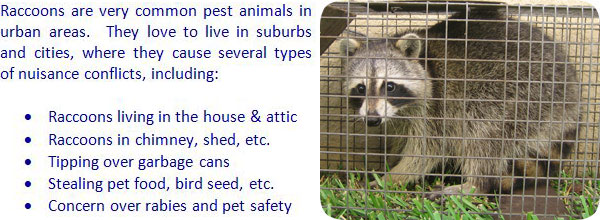
We perform raccoon removal in over 1700 USA locations - serving the whole USA.
It is my goal to educate the public about raccoons and other wildlife, and
provide tips for safe, effective, and responsible wildlife removal. Remember, to solve many raccoon problems, the best
bet is prevention and sealing shut entry holes: inspect your house to find animal entry holes.
Summary of Step-By-Step Instructions If OUTSIDE:
1) Purchase large cage traps - rated raccoon size, usually about 10" x 12" x 30" or so.
2) Set traps in areas of high raccoon activity. Bait with marshmallows, or, if stray cats are not a problem in the area, cat food works as well. Make sure traps are scent-free and flush to the ground, and set in the shade.
3) Relocate any trapped raccoon at least 10 miles from capture site. Never relocate a female raccoon in spring with visible nipples (nursing a nest of baby raccoons nearby).
4) If you have raccoon living under a deck, shed, or other structure, install an exclusion barrier - steel mesh around the perimeter, and down at least 12 into the ground, with bottom of mesh sloping outward.

Summary of Step-By-Step Instructions If IN THE ATTIC:
1) Inspect the house to find out how they are getting inside - likely somewhere on the roof, or eaves.
2) Search inside the attic, and find the next of baby raccoons (there is a 90% chance of babies). You must find them. Remove them by hand, wearing thick gloves and a pillowcase for carry.
3) Use the baby raccoons as live "bait", in the back of large cage traps, using a trap divider. This is a difficult set to get right. Make sure the sides of the trap are blocked off to prevent reach in.
4) Once you've trapped the mother, relocate them all together, at least 10 miles from capture site.
5) Repair the entry hole and clean and decontaminate the raccoon feces out of the attic.
Need raccoon removal in your hometown? We service over 500 USA locations! Click here to hire us in your town and check prices - updated for year 2020.
In the last few decades, raccoons have shifted from a wild animal to an urban animal, like rats or pigeons. They are generally strong, intelligent, and talented, and thus they are also commonly destructive.
I believe that raccoons should be dealt with humanely, and also effectively.
How to get rid of Raccoons In the Attic - This is not an easy job. The animal is almost certainly a female with a litter of baby raccoon in the attic. That's why most raccoons break into homes or on roofs. You have to remove the babies in addition to trapping
and removing the adult female. It is a very difficult job with many variables, and takes a lot of experience. You can remove the litter by hand and use them as bait to trap the mom. Or you can remove them and exclude her, but if you don't trap the adult, she'll
break back in, and if you don't get the babies, they will claw at things, starve to death, rot and stink.
How to get rid of Raccoons In the Yard, Swimming Pool, Garbage Cans, etc. - You want to eliminate whatever is attracting them to the property. But once they have habituated to an area,
you might need to trap and remove them. Read more information about raccoon trapping here, including tips on traps, sets, types of bait, techniques, etc.
Click below photos for raccoon removal examples by the pros:
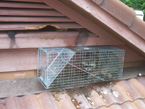 |
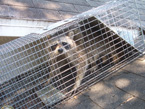 |
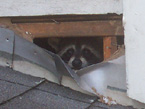 |
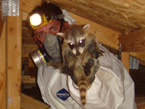 |
Raccoons are one of the most recognizable and destructive critters in all of North America. These mammals once lived in meadows and wooded areas, but have realized that living alongside humans yields bigger food scores and now make their homes in rural and urban environments. If you have ever lived in a house or near a raccoon's home then you have probably been paid a visit or two from these furry neighbors.
Once a raccoon has learned that you have food, they will pay you a visit often in search of food or shelter. They are not afraid of humans or domestic animals and will wander into your garage, tip over your garbage cans and find a way into your attic if they can. Raccoons will also eat up all of your fruit and vegetables if you have a garden. If you have ever had, or do have a raccoon problem, then you probably already know how hard it is to get rid of them. Now the question is how do you get rid of raccoons? There are several ways to get rid of raccoons in an effective and safe manner for both your family and the animal. Here are some that you can try:
- Keep the raccoon out of your trash. If you deny the raccoon access to your trash, then they have no other option but to move on to someone else's house. You can do this several ways. You can get a trashcan that has locks on it or is very difficult to open, but raccoons are excellent problem solvers so you may as well be throwing your money away. The best thing that you can do to cut off the raccoon's food supply is to lock up your trashcans in a shed or your garage and make sure that the garage and/or shed is secure at all times and only take the garbage cans out the morning that the trash truck comes.
- Keep the yard clean. Another thing that you can do to force the raccoon to move on is to keep any type of food out of your yard. Do not feed your dogs or cats outside and do not leave your left over food from picnics outside. Also if you have a fruit tree, make sure that you are cleaning up the felled apples, peaches, etc. on a regular basis. If you have an outside garden, construct a good fence around it, or even an electrical fence to keep the raccoons out. They will soon learn that they get an unpleasant shock every time they try to eat that food and will stop trying to get into it. However, this is not a fool-proof way of keeping them out because, again, raccoons are very smart and will probably figure out a way to get to the food. Read about how to keep raccoons away - prevention techniques.
- Scare it off. Probably one of the most effective ways to rid your yard of pesky raccoons is to get an automated/motion-activated sprinkler system to scare them off every time they come near your trash cans or gardens. There are many products on the market for this type of device and they really work because they were developed specifically to deal with this problem. The best part of these types of devices is that they work on other animals such as deer and stray dogs and cats as well.
- Trapping the raccoon. This is not a recommended way to get rid of your raccoons, but it may be the only option available to you. You can decide to do this yourself or hire an exterminator/animal control officer to set up the trap for you. You have to make sure that the trap is durable enough and safe enough to trap the raccoon and can be loaded with any type of food. Once you have caught the culprit, do not kill it, but instead take it to the nearest wooded area (at least 15 miles away from your house) and set it free.
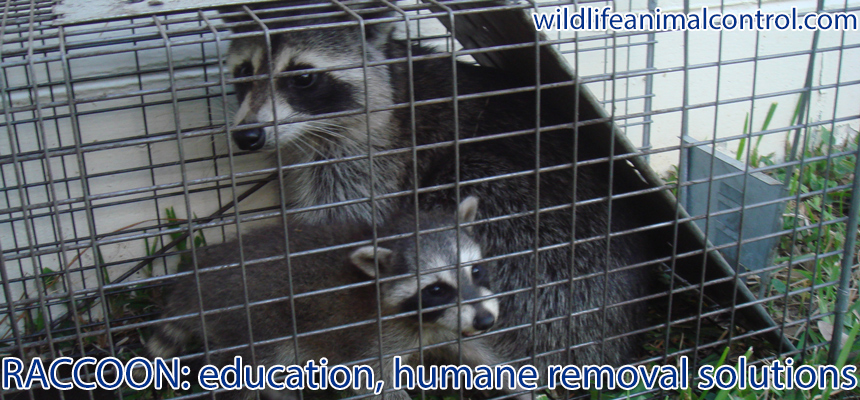
More in-detail how-to raccoon removal articles:
Information about how to kill a raccoon - with poison or other methods.
Information about how to catch a raccoon - remove one stuck in the house.
Information about raccoon repellent - analysis of types and effectiveness.
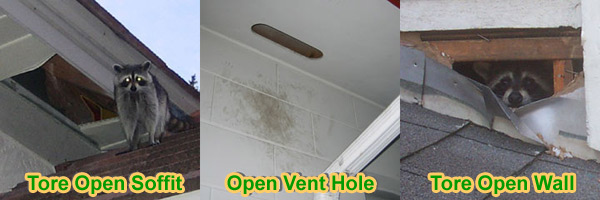
Raccoon Information and Facts
Raccoon Appearance: Though weight may vary from eight to twenty pounds, raccoon species share the same distinctive black markings around the eyes, surrounded by lighter facial fur and often white bands. The dark fur around they eyes is considered an adaptation to increase the ability to see in the absence of daylight. A mixture of light and dark, longer hair comprises the body and consists of two layers, the inner lay of insulating fur and the outer layer of coarse hair that serves to repel water. Raccoons have a bushy tail with a contrasting ring pattern; the tail serving as a point of balance while climbing as well as an added layer of warmth while sleeping in cold weather. Primary senses for the raccoon include the sense of touch and smell, with the ability to see in the dark a close third. The paws of these animals are composed of sensitive tissue that makes it possible for the raccoon to identify an object by touch alone. They do not possess the thumbs of primates, so the ambidexterity of the species is limited.
Raccoon Habitat and Behavior: It was once assumed that raccoons were completely solitary creatures. That theory has been widely disproven, though raccoons are most often seen alone and not in groups. Females of the species will often commune together at appointed feeding locations or in a group area for sleeping. Male raccoons seem to only be social during the mating season, and this interaction with others is based mostly on breeding status and not companionship. Both male and female raccoons will share a living space if something exceptional—like an abandoned building—is located. Originally from woodland areas, the raccoon has adapted to life in or near cities as well, though ideally the creatures remain in a location where a vertical surface is conducive to climbing. Climbing trees is the staple for raccoon safety, and for that reason, you will not often find them in open spaces or too close to a sandy coast. Mating season for this animal occurs for approximately three months in the spring and early summer, with females mating with multiple males. The average litter size is three to five kits. Male raccoons tend to be hostile toward unknown young, and for this reason most females will become completely solitary while raising their offspring. At about sixteen weeks, the kits are old enough to be on their own, but the mother will often allow her brood to remain in the den until after the first year.
Raccoon Diet and Hunting: Raccoons have an impressive array of acceptable food sources, and it is not uncommon for the individual raccoon to have a personal inclination toward a specific item of the diet. Raccoons will eat insects, amphibians, berries, fruit, nuts, and even smaller mammals. They will scavenge for human garbage and will eat anything from potato chips to chicken wings with sauce. During the months when food is readily available, raccoons prefer acorns and berries over many meat sources, though they seem to enjoy fishing and catching amphibians. Buildup of fat is important to the raccoon. During the cold months, they will become less active, though the decrease in activity is not a true form of hibernation.
Raccoon Nuisance Concerns: Because of their high intelligence and problem solving skills, the ingenuity of the raccoon is often seen as a nuisance problem for humans. Raccoons are opportunistic feeders, and they can remember locations of food—and how to unlatch or open containers—for up to three years. This impressive memory recall makes raccoons repeat offenders when it comes to home invasion and garbage scavenging. The cleanup involved with a scavenging raccoon is less of a hassle than the cleanup involved with a raccoon that has ruined building materials in an attic or garage from creating a den site. These animals are disinclined to attack house pets, but will if the pet initiates the confrontation. Species squabbles raise the concern of rabies, a common virus found in wild raccoons. The most common issue we deal with
is the scratching sounds in the attic or walls from raccoons.
Raccoon Diseases: Raccoons are the prime vector for rabies virus. For unknown reasons, though it is suspected that the large brain cavity of the raccoon is of primary influence, rabies virus thrives in this specific species. Because of this, raccoons are always suspect for the disease even if no symptoms are
discernible. Raccoons are also known to carry leptospirosis, a bacterial infection that affects the kidneys of humans and other mammals. Lesser concerns center on the intestinal parasites spread by raccoons, some of which can be ingested by humans and can cause serious debilitations in young or elderly people. Raccoons are most frequently killed in nature by distemper virus, though this is not a disease that can be passed the humans.
Read more educational articles about raccoons. Learn how to keep a raccoon out of your swimming pool , and what to do if you find an Orphaned Baby Raccoon. Learn what kind of noises and sounds raccoons make, and all about their mating habits. Find out if homeowners insurance pay for raccoon damage and learn about Raccoon Eviction Fluid . Learn, too, about how to identify raccoon feces.
Learn if raccoons will attack cats, dogs and other pets?, and what to do if you are bitten by a raccoon. I can let you know if you should feed a baby raccoon, the symptoms of a sick raccoon, and what equipment is needed to trap raccoons. Find out if repellents will get a raccoon out of your chimney and just what kind of damage one can do in your attic. Learn if raccoons can climb fences, if they can swim or hibernate, how well they are able to jump, and just how smart they are. I can let you know how dangerous raccoons can be towards pets and why raccoons Die Inside Houses.
Learn if they burrow and dig holes and what kinds of diseases raccoons carry. I can let you know if raccoons can open doors or windows, and if they eat rats or mice. Learn about raccoon roundworm and what to do about a Raccoon under the porch. Read more about if it is legal for you to trap a raccoon, if raccoons live or sleep in trees, and how to identify raccoon tracks. Find out why raccoons tear up sod, if the city or county animal services, where to relocate a trapped raccoon. I can also let you know what wildlife rehabilitators do with raccoons and share my best advice on how to keep raccoons out from under your porch.
This site is intended to provide raccoon education and information, so that you can make an informed decision
if you need to deal with a raccoon problem. This site provides many raccoon control articles and strategies, if
you wish to attempt to solve the problem yourself. If you are unable to do so, which is likely with many
cases of raccoon removal, please go to the home page and click the USA map, where I have wildlife removal experts
listed in over 500 cites and towns, who can properly help you with your nuisance raccoon.

















